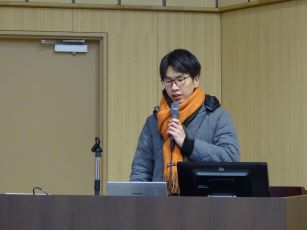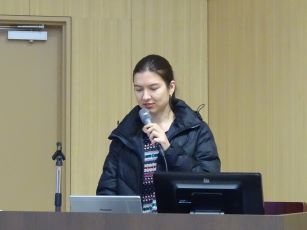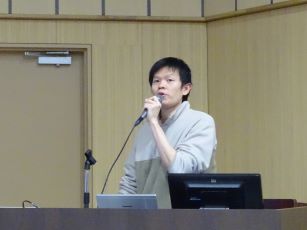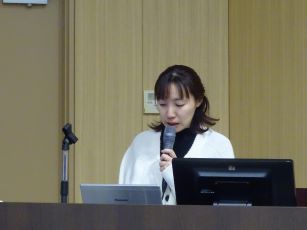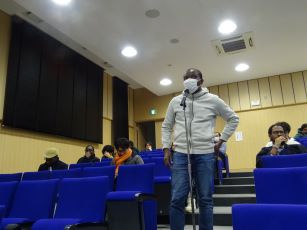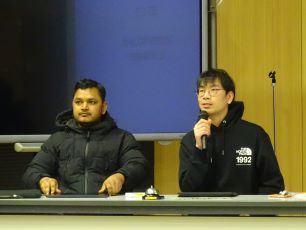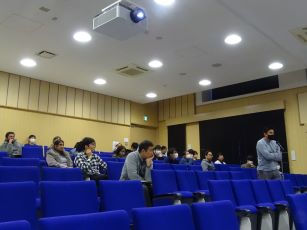- Home
- Student Activity
- Student Monthly Progress #9
The 9th Student Monthly Progress presentation was held on December 22nd, 2023.
【Presenters】
1. KAWAKAMI Yuki:Laboratoty of Veterinary Internal Medicine
<Relationship between intratracheal pressure and swine lung surface shear wave speed>
2. KOVBA Anastasiia:Laboratory of Wildlife Biology and Medicine
<SARS-CoV-2 surveillance in Hokkaido wildlife>
3. HEW Yik Lim:Laboratory of Microbiology
<Continuous introduction of H5 high pathogenicity avian influenza viruses in Hokkaido, Japan; characterization of viruses isolated in the winter of 2022–2023>
4. KAWAGUCHI Nijiho:Division of Molecular Pathobiology
<Comparison of the viral infectivity between the fixed and street strains of Rabies virus in peripheral tissues>
【Chairpersons】
ISLAM MD Mominul:Laboratory of Physiology
NARONGPUN Pawarut:Division of Bioresources
❖Chairpersons’ Report ❖
KAWAKAMI Yuki conducted a fundamental investigation to distinguish various pulmonary diseases using lung surface shear wave elastography (SWE). Oxygen was introduced into the lungs of pigs to examine the correlation between airway pressure and the shear wave speed (SWS) on the lung surface. His findings suggest that SWE can be utilized to assess the elasticity of the lung surface affected by disease, indicating its potential for distinguishing different diseases of the lung. Moving forward, he intend to explore whether SWE can identify alterations in lung surface elasticity in diseased lungs in laboratory animal models.
KOVBA Anastasiia aimed to evaluate the exposure of wild animals to SARS-CoV-2 in Hokkaido, Japan. She collected nasal swabs and blood samples from three species captured in various parts of Hokkaido prefecture from March 2022 to February 2023. She performed qRT-PCR using nasal swabs RNA for viral screening. She also conducted multispecies SARS-CoV-2 N-protein ELISA for initial antibody screening using serum samples. For additional confirmation, ELISA-positive samples were tested using IFA and virus neutralization test. She found that there was no viral RNA detected in nasal swabs from raccoons (0/184), sika deer (0/107), and brown bears (0/14), indicating that the virus was unlikely to widespread within the population of raccoon, sika deer and brown bear. However, one raccoon, one brown bear, and two sika deer tested positive in the antibodies screening with multispecies SARS-CoV-2 N-protein ELISA, but subsequent investigations with other serological methods suggested the absence of anti-SARS-CoV-2 specific antibodies, emphasizing the importance of confirming serological screening results. She came with the conclusion that SARS-CoV-2 was unlikely to spillback from humans to wildlife in Hokkaido during the study period.
HEW Yik Lim’s research is focused on monitoring and characterizing High Pathogenicity Avian Influenza (HPAI) viruses in birds and mammals in Hokkaido during the winter of 2022–2023. The study involved the analysis of 30 HPAIV isolates, specifically subtyping and pathotyping through sequencing the hemagglutinin (HA) gene. Phylogenetic analysis revealed that all isolated HPAIVs belonged to clade 2.3.4.4b and were further categorized into three groups (G2b, G2c, and G2d). Additionally, examination of all eight gene segments identified six types of gene constellations. The antigenicity of the isolates remained consistent in recent seasons, but slight differences were observed in isolates from the 2010s. The research also assessed the pathogenicity of four representative isolates by intranasally challenging two chicken breeds. All chickens, except one broiler chicken, succumbed to the infection within 5 days, highlighting varying pathogenicity among the viruses. Notably, one HPAIV strain exhibited significantly lower pathogenicity in broiler chickens compared to layer chickens. The study emphasized the complexity of HPAIV characteristics in Hokkaido, influenced by bird migration routes, and suggested the potential global dispersal of these viruses.
In KAWAGUCHI Nijiho's study, the primary focus is on the complexities of Rabies virus (RABV) infection dynamics, particularly during the latent periods, and seeks to elucidate differences between fixed (CVS) and street (Toyohashi) strains. The investigation centers on understanding the infectivity in peripheral tissues, employing a comprehensive approach. The in vitro analyses unveiled unique characteristics of the two strains. The CVS strain exhibits a constrained growth pattern in myoblasts, suggesting a limited affinity for these particular cells. In contrast, the Toyohashi strain showcases a notably higher infectivity rate in muscle tissues, hinting at a more pronounced interaction with myoblasts and potentially influencing the infection dynamics in muscle tissues. Furthermore, the in vivo experiments revealed a nuanced contrast between the strains. The CVS strain displays higher neurotropism, emphasizing an affinity for nerves, albeit with less myotropism, suggesting a reduced preference for muscle tissues. In contrast, the Toyohashi strain demonstrates a higher degree of infectivity in muscle tissues. Further insights are gained through the use of recombinant RABV carrying a far-red fluorescent protein (E2-Crimson). The Toyohashi strain's signals are observed in both nerves and muscles, revealing a broader distribution within the peripheral tissues. On the other hand, the CVS strain's signals are exclusively localized in nerves, highlighting a more focused infection pattern. However, the study acknowledged the difficulties in differentiating RABV-specific signals from non-specific signals, prompting the consideration of in-situ hybridization to confirm signal localization.
